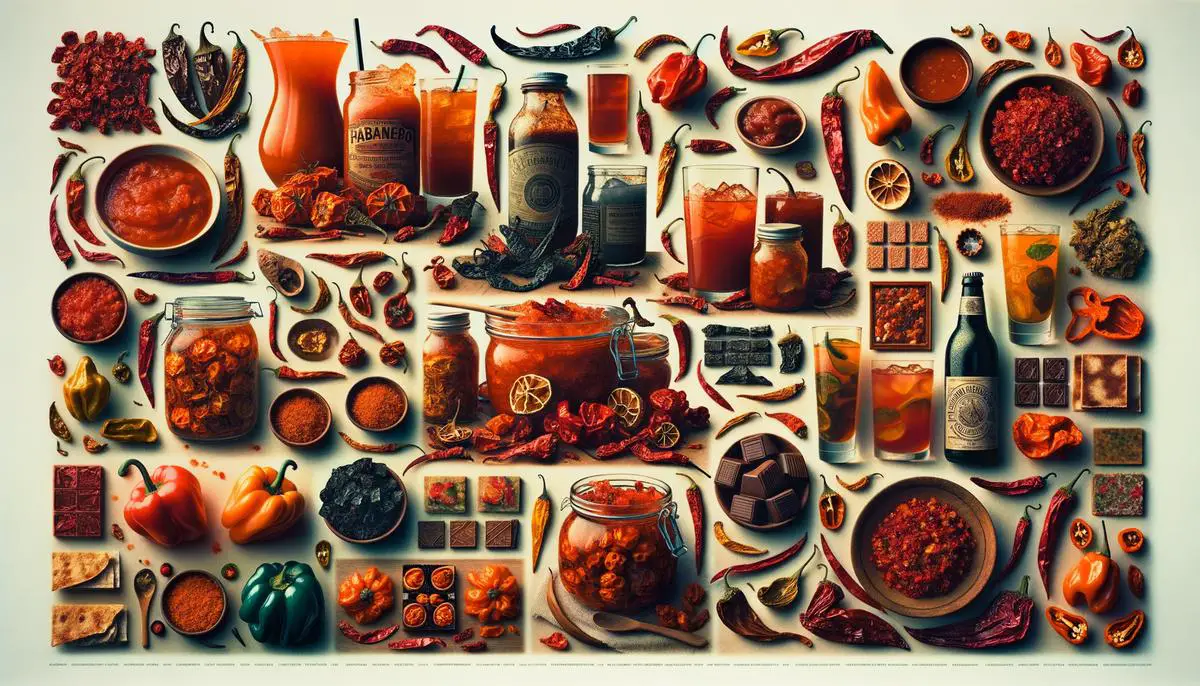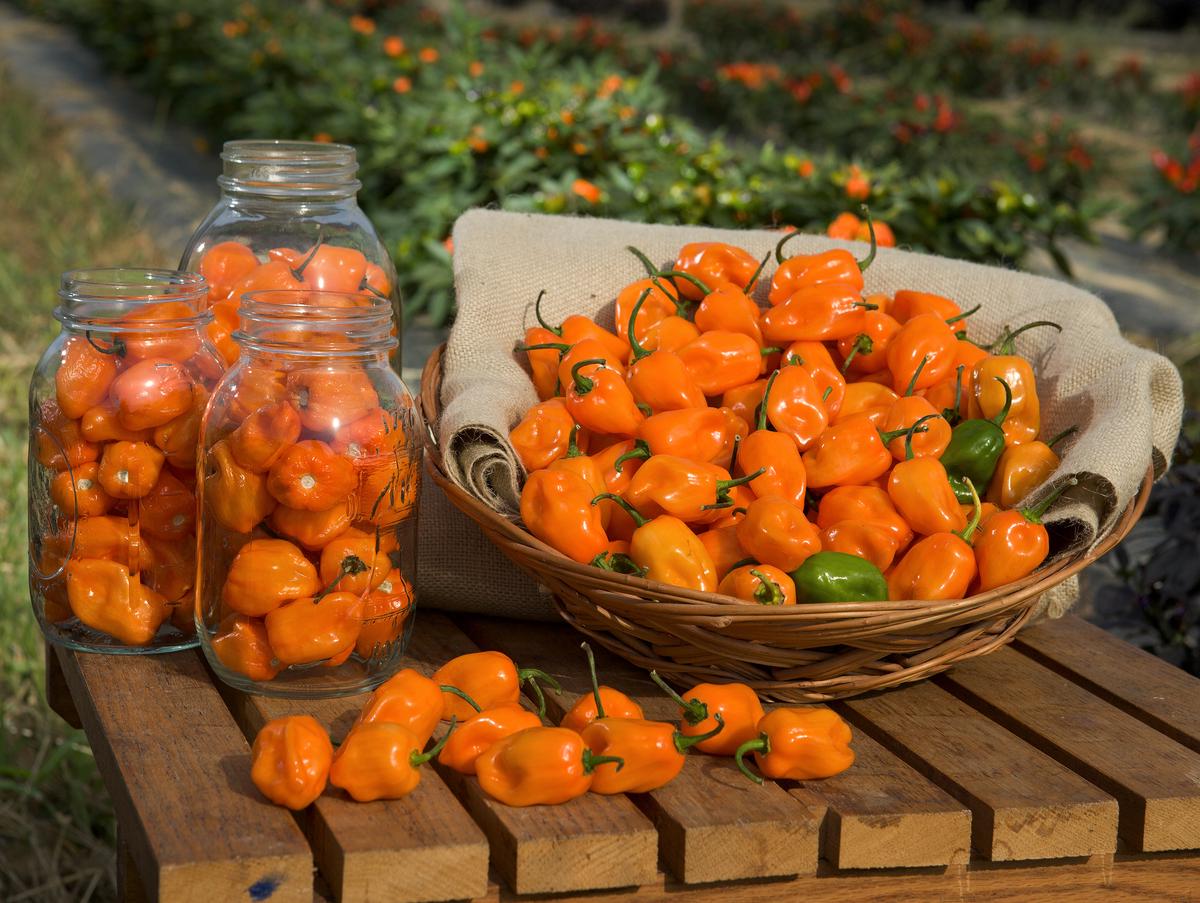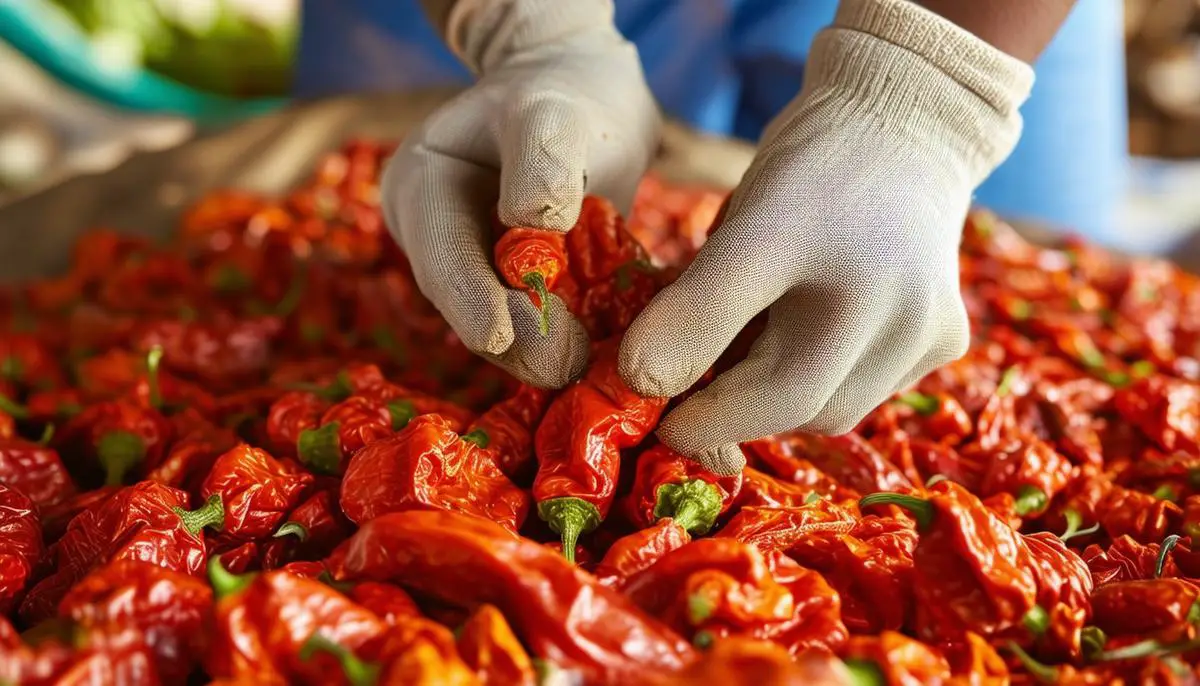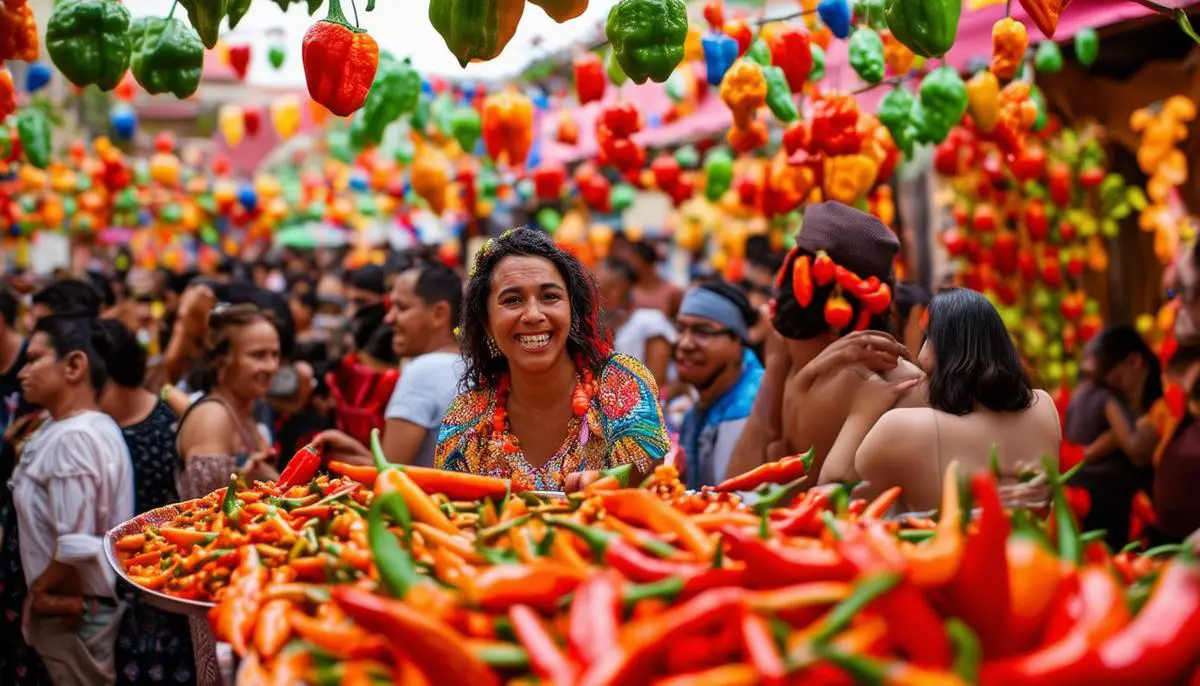
Historical Context and Origin
Habanero peppers, traced back to approximately 8,000 years ago, originated in the Amazon region. Early tribes recognized their culinary potential and began integrating these fiery chiles into their diet. As trade networks expanded, the habanero reached the Yucatan Peninsula, where the dry and hot climate fostered its proliferation. It became intertwined with the cultural and culinary practices of the Maya and other indigenous groups.
Further dispersal by traders carried the habanero across seas and continents, gradually embedding itself in global gastronomy. The name "Habanero," meaning "from Havana," reflects its journey through Cuba, a bustling trade hub frequently visited by Spanish merchants. Today, dried habanero peppers uphold a revered status in gourmet kitchens worldwide, especially celebrated in Mexican cuisine.
Despite its explosive spiciness, the habanero's appeal extends beyond its heat. Its rich aroma and subtle sweetness complement an array of dishes, marrying well with ingredients as diverse as fruits and robust meats. This versatility has cemented the habanero's rank as a steadfast enhancer of dishes that excites palates on a global scale.

Culinary Uses
Dried habanero peppers bring a spectrum of zestiness to the kitchens of innovative chefs and culinarily-curious souls. In the universe of vibrant spices, habaneros burn brightly, perpetuating a tradition of heat with exceptional depth. The incorporation of dried habaneros has transformed many traditional plates into complex culinary expressions.
Adding flare to salsas is a habanero's primitive culinary charm. Carefully integrating minced bits of this dry gem accentuates a dimensional spice to tomato-based offerings, melding seamlessly with onions, coriander, and lime. Habaneros also intertwine within marinades that douse meats destined for the grill, bestowing a fervent glow upon carne asada or saucy barbacoa.
Modern alchemy in high-end culinary arts has spun a novel yarn for dried habaneros. Artisanal chocolatiers sprinkle finely ground flakes over cacao bounties, teasing palates with contrasts, defying convention, espousing sweet heat. In cocktails that sway to tropical rhythms, habanero syrups converse zestfully with tequilas and rums, injecting a spirited spice dance among citrus sways and sugary croons.
Dried habanero peppers burn within culinary arsenals, awaiting new tales to taste and tell, ensuring every sampling resonates with the profound symphony of life's flavors.

Health Benefits
The healthy aspects of the fiery habanero are influenced by its generous enclosure of vitamins and nutrients. Rich in Vitamins A, C, and E, these peppers offer an armory of antioxidants poised to combat free radicals, lending a substantial hand in the orchestration of bodily health. This vitamin ensemble fortifies eye health, bolsters the immune system, and ensures skin's resilience.
Packed within the habanero is the metabolic maestro, capsaicin. Known primarily for its pivotal role in providing the pepper's heat, capsaicin also charms as a metabolic booster. It reigns as a catalyst in enhancing thermogenesis, thus converting calories readily into warmth instead of stored fat.1 Integrating habaneros into a diet could rev up metabolism, aiding weight loss endeavors in a deliciously spicy fashion.
Traditional uses of this zestful pod further testify to its ingrained worth across cultures. Ancient practices respected the habanero for its medicinal properties, harnessing its potency to ward off illnesses and manage pain. Modern medicine now taps into its capsaicin content for manufacturing topical creams that assuage chronic pain affiliated with arthritis and diabetic neuropathy.2
As culinary artisans continue to support habanero's robust profile in kitchens worldwide, the health merits accompanying these culinary adventures spring forth. The mere culinary use transforms into a jubilant banquet of health, evident in its ties to wellness and metabolic integrity. As palates adjust to its spice, bodies celebrate the silent nurturing medicinal capsules delivered with transformative flair.

Handling and Preparation
Before unlocking the explosive palette that dried habanero peppers have to offer, one must master the practice of handling these capsaicin-laden powerhouses with precaution. The same compound that dispatches a delightful incendiary tang also poses a formidable threat if mishandled.
- Protective gear: First and foremost, donning gloves is non-negotiable. This protective barrier prevents the capsaicin from embedding itself onto the skin and causing irritation.
- Toasting: Once securely prepared, a chef poised to work with dried habaneros can engage in the technique of unlocking the flavors. Toasting is a celebrated rite that awakens the resting intense flavors. A dry skillet over medium heat sets the stage. The peppers demand constant vigilance; turning frequently to avoid scorching. A brief encounter with heat—just until they emit their rich, smoky-fruity aroma—is sufficient to embolden them.
- Rehydration: Rehydration follows for those looking to soften dried habaneros to incorporate into sauces or stews. Submerging them in warm water for about 15 minutes, or until they soften, foretells an ensuing transformation. This technique is particularly pertinent when a smoother texture is paramount.
- Grinding: Grinding is yet another transformative preparation. Mortar and pestle can be employed to exert dominance over the softened or toasted habaneros, breaking them into a powder or paste that commands any dish it embraces.
Through enlightened handling techniques—respectful protection, intentional toasting, mindful rehydrating, and meticulous grinding—the sumptuous potential enshrouded in dried habanero peppers unfolds elegantly.

Comparison of Heat Levels
In the symphony of spices that set the culinary world alight, the habanero pepper occupies a seat of honor among high-intensity chilies. Commanding Scoville heat units (SHU) ranging from 100,000 to 350,000, this force of nature renders the chef and connoisseur gaunt-eyed as they negotiate its usage in dishes that flirt boldly with the edge of fiery gusto.
The habanero's position relative to its pepper peers elevates it further in the culinary hierarchy.
- The more commonly used jalapeno, with SHU clocking in between 2,500 to 8,000, is akin to a gentle murmur in comparison.
- The serrano, often deceptive in its compact green symmetry, touches the mid-level piquancy scale at 10,000 to 25,000 SHU, still hermitting in the habanero's swelling shadow.
- Forging ahead in this pecking order, one might encounter the bhut jolokia or ghost pepper, an audacious combatant transcending the habanero on the spicy ladder, boasting 800,000 to over 1,000,000 SHU.3
The habanero remains a pepper not quite in the upper echelons of scalding extremity but possesses enough spiciness to command respect from even the most accomplished fire-eaters.
This juxtaposition of heat lends the habanero a profoundly versatile narrative in haute cuisine: capable of being both mightily dominant or cunningly subtle. Its presence in kitchen arsenals strategically alters culinary outcomes and gastronomic experiences.
Chefs utilize habanero with practiced respect for its magnitude of heat, distinguished not solely by Scoville scores but hinged on its capability to intermingle without overshadowing the symphony of complementary flavors in sophisticated dishes. Aficionados appreciate the judicious use, where its heat elegantly pirouettes through complex flavor profiles, whispering its presence rather than declaiming it outright.
Through cultivated usage and profound companionship with other ingredients, habaneros transcend their Scoville defined intensity. Every application in gastronomical practice proves them as ambassadors of extreme heat and inherent carriers of flavor dimensions untapped by less formidable chilies.
Cultural and Social Impact
Festivals and communal rituals dedicated to habanero peppers unite communities in spirited conviviality. These events, extending from Mexico's Yucatan Peninsula to various corners of the globe, revolve around the celebration of the beloved yet fearsome pepper, emblematic of courage and revered for its culinary flame.
These festivals are odes to what some regard as the heart-beating pulse of local heritage—days brimming with contests of culinary prowess and spirited soirees where habanero-infused dishes thrill the daring. Audiences bask in the camaraderie of shared, breath-halting experiences, ignited by capsaicin flooding palates and sparking laughter at the challenge of enduring such formidable heat. The social fabric of these gatherings remembers its threads as individuals forge connections through shared vulnerability to the chili's heat and the collective recovery that induces laughter spilled over morsels tinged with fire.
In the kitchens of daily life, where flames lick pots and pans serenading ingredients into culinary symphonies, habaneros enter as cherished but potent aromas. A communal cooking initiative might see these bright nuggets minced or ground into vibrant sauces shared across family lines or community celebrations, providing a medium through which stories, traditions, and gastronomic secrets leap generations, reinforcing identities intertwined with the storied pepper.
Each insertion of habaneros into soups, stews, or salsas is a ritual, many hands reprising the ancient roles of those predecessors who first unearthed its piquancy: a culinary bravery, enhancing both fare and the heat that infuses bonds between hosts and guests alike. The capsaicin's sting rapidly turns discomfort into deep, resonant exchanges of respect and appreciation, elevating the habanero above mere foodstuff to cultural ambassador, clad in spice yet embracing all with warmth.
Stacked on marked shelves or strung up as vivid garlands of anticipation at local markets, habaneros operate as culinary anthems to the sheer range and diversity of humankind's pursuit of flavor. They become emblems—a powerful call to cultural bravery—with each peel waving the banner of places thriving on heritage richness accentuated by a peppery vestige. Food adventurers and celebrated chefs chase sublime experiences through tales spun by sinking teeth into habanero-imbued delicacies, reenacting explorational decadence interwoven through ancient to modern times.
Herein thrives a gripping dichotomy: habaneros contribute viscerally to community enjoyment and embody spiritual and enduring bequests syncing with emotional partnerships with food and company. In this savoring and daring acquaintance with the habanero lies refined vivacity—a bridge through historical culinary time, agile across festivals and kitchens where unity is mirrored in shining, rigorous crescents of these potent pearls. Habaneros cultivate spices' concurrent dialects of pain, pleasure, adventure, and connection, potently curating a symposium of tales pierced amply with sear and affection.

In Conclusion:
While habanero peppers are renowned for their scorching heat, it's their dynamic contribution to both cuisine and community that truly defines their essence. These potent pods do more than just spice up a meal; they enrich our palates and weave into the fabric of cultural traditions, making every bite a testament to their storied past and versatile present.
- Habaneros unite communities through festivals and rituals1
- They provide a medium for sharing stories, traditions, and gastronomic secrets across generations2
- Habaneros elevate from mere foodstuff to cultural ambassadors3



